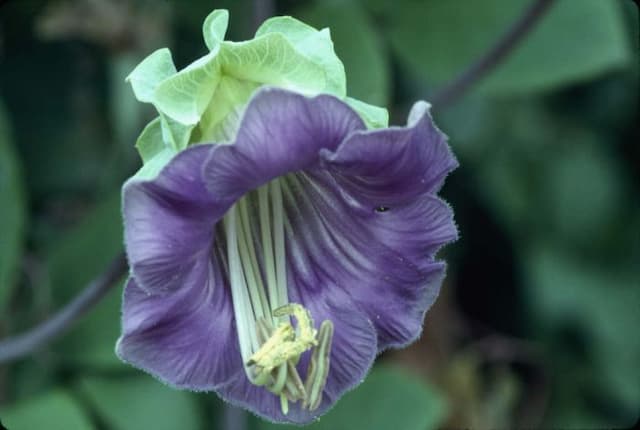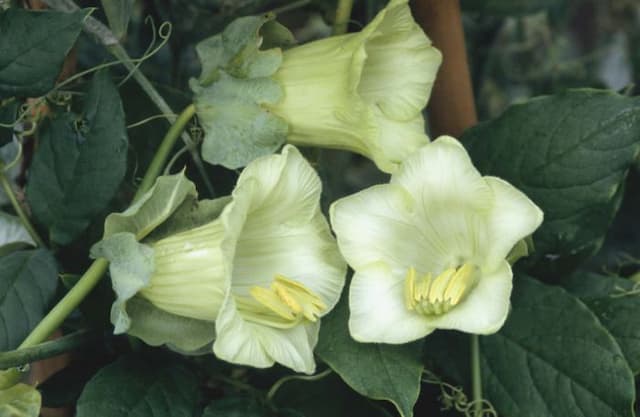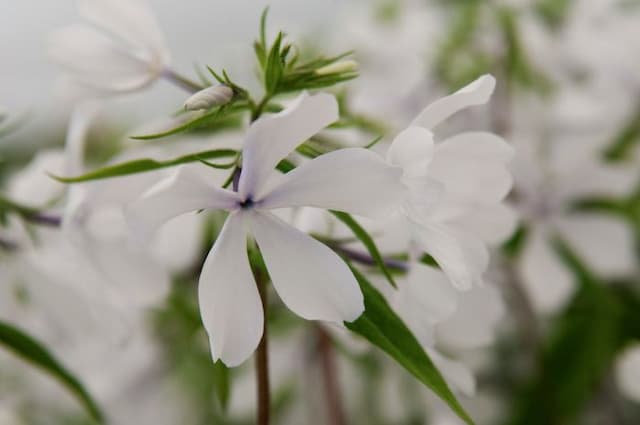Smooth Phlox Phlox glaberrima 'Bill Baker'

ABOUT
Phlox glaberrima 'Bill Baker' is a flowering plant known for its vibrant and showy blooms. The plant boasts clusters of flowers that are typically a striking shade of color, often attracting various pollinators like bees and butterflies. Each flower within the clusters has a distinct, symmetrical shape with five petals that spread out from a tubular center. This provides the cluster with a lush, full look that can add a pop of color to gardens or natural settings. The leaves of 'Bill Baker' are smooth, with a glossy texture and an ovate to lance-shaped appearance. They are arranged in an opposite fashion along the stems, which creates an organized and clean foliage presentation. On maturity, the leaves often take on a rich green hue, forming a pleasant contrast with the bright flowers above them. Stems of the plant are sturdy and emerge from a base that typically forms a clumping habit, contributing to the overall lushness of the plant. In the appropriate seasons, 'Bill Baker' is covered in its distinctive flowering clusters, which can be seen densely packed at the tips of the stems, presenting an almost carpet-like appearance of color in full bloom. Overall, 'Bill Baker' is a strikingly beautiful addition to any setting, appreciated for its ornamental flowers that carry a cheerful and vivid appearance, as well as for its neat green foliage that supports the spectacular blooms. It is often utilized in borders, as a ground cover, or in container gardens to add visual interest and attract wildlife.
About this plant
 Names
NamesFamily
Polemoniaceae
Synonyms
Smooth Phlox, Marsh Phlox, Bill Baker Phlox
Common names
Phlox glaberrima
 Toxicity
ToxicityTo humans
Smooth Phlox is not commonly known for being toxic to humans. There is limited information suggesting that if any part of the plant is ingested, it could potentially cause mild stomach upset, but generally, it does not pose a significant risk of poisoning to humans. As with any plant, sensitive individuals may experience an allergic reaction, but serious consequences are unlikely.
To pets
Smooth Phlox is not commonly known for being toxic to pets such as dogs and cats. It is considered non-toxic, and there is limited information suggesting any serious risk if pets ingest this plant. However, it is always possible for animals to have a slight digestive upset if they consume a large quantity of non-food items, including non-toxic plants. No specific symptoms of poisoning by Smooth Phlox in pets have been widely reported or documented.
 Characteristics
CharacteristicsLife cycle
Perennials
Foliage type
Deciduous
Color of leaves
Green
Flower color
Pink
Height
2 feet (0.61 meters)
Spread
2 feet (0.61 meters)
Plant type
Herb
Hardiness zones
4
Native area
North America
Benefits
 General Benefits
General Benefits- Aesthetic Appeal: Adds vibrant color and visual interest to gardens and landscapes.
- Attracts Pollinators: Provides nectar for butterflies, hummingbirds, and bees, supporting local ecosystems.
- Ease of Care: Generally low-maintenance once established, requiring minimal upkeep.
- Drought Tolerance: Once established, it can tolerate periods of drought, making it suitable for xeriscaping.
- Fragrance: Some varieties emit a pleasant scent that can enrich the sensory experience of a garden.
- Ground Cover: Can be used effectively as ground cover to reduce soil erosion and suppress weeds.
- Versatility: Suitable for borders, rock gardens, and as a general garden plant due to its adaptability.
- Long Blooming Period: Often blooms from spring to summer, providing long-lasting color in the garden.
 Medical Properties
Medical PropertiesThis plant is not used for medical purposes.
 Air-purifying Qualities
Air-purifying QualitiesThis plant is not specifically known for air purifying qualities.
 Other Uses
Other Uses- Phlox 'Bill Baker' can be used as a natural dye. The flowers provide varying shades of pink to purplish pigments for dyeing fabrics or yarn.
- The dense mat-forming habit of Phlox 'Bill Baker' makes it an excellent ground cover to prevent soil erosion on slopes and in garden areas prone to soil loss.
- The plant attracts pollinators; it can serve as an ecological enhancer by encouraging bee, butterfly, and hummingbird populations in gardens.
- The dried flowers of Phlox 'Bill Baker' can be used in potpourri mixes, adding fragrance and color to a room when placed in decorative bowls.
- Garden designers often use Phlox 'Bill Baker' for its aesthetic value in rock gardens due to its low-growing habit and vibrant flowers.
- This plant can serve as a natural marker of seasons, as it blooms reliably each year, indicating the arrival of spring or summer in temperamental climates.
- The flowers of Phlox 'Bill Baker' can be used in edible flower preparations, such as salads or garnishes, though they are more commonly appreciated for their beauty than their flavor.
- Phlox 'Bill Baker' can be employed as part of a sensory garden experience, providing soft textures for tactile exploration and sweet fragrances for olfactory enjoyment.
- The plant's foliage provides a lush green backdrop in floral arrangements, enhancing the overall design without competing with the primary flowers.
- In art, Phlox 'Bill Baker' can act as a subject or inspiration for botanical illustrations, capturing the delicate structure and vibrant color of its flowers.
Interesting Facts
 Feng Shui
Feng ShuiThe Smooth Phlox is not used in Feng Shui practice.
 Zodiac Sign Compitability
Zodiac Sign CompitabilityThe Smooth Phlox is not used in astrology practice.
 Plant Symbolism
Plant Symbolism- Harmony: Phlox has long been associated with the idea of harmony, as its dense clusters of flowers bloom together in a harmonious display.
- Unity: Reflecting the tight groupings of its flowers, phlox symbolizes unity, representing the coming together of people or ideas.
- New Beginnings: The blooming of phlox often signals the arrival of spring and is seen as a symbol of fresh starts and new opportunities.
- Agreement: Its tendency to spread can represent consensus or agreement within a group.
 Water
WaterSmooth Phlox should be watered regularly, aiming for about 1 inch of water per week, including rainfall. In the absence of rain, water deeply once a week with approximately 0.625 gallons per square foot of soil, ensuring moisture reaches deep into the root zone. During hot, dry periods, increase watering frequency to avoid stress, but allow the soil to dry out slightly between watering sessions to prevent root rot. Reduce watering in the fall to prepare the plant for winter dormancy.
 Light
LightSmooth Phlox thrives in full sun to partial shade. The ideal spot for this plant is in an area where it can receive at least 6 hours of direct sunlight per day. If located in a region with very hot summers, afternoon shade can help prevent scorching of the leaves. However, too much shade can result in leggy plants and reduced flowering.
 Temperature
TemperatureSmooth Phlox favors temperate conditions and can generally withstand temperatures as low as 0°F and as high as 85°F. For optimal growth, the plants prefer a temperature range of 60°F to 75°F. They are hardy in USDA zones 4 through 8.
 Pruning
PruningPrune Smooth Phlox after blooming to encourage a second bloom and to maintain a tidy appearance. Cut back the spent flower stems by one-third to one-half their height, which can stimulate reblooming in fall. In late winter or early spring, before new growth begins, prune away any dead or damaged stems to promote healthy growth and air circulation, which can reduce the risk of disease.
 Cleaning
CleaningAs needed
 Soil
SoilSmooth Phlox thrives best in a rich, moist, well-draining soil mix with a pH ranging from 5.8 to 6.8. Incorporate organic matter like compost or peat moss into the soil to enhance its structure and fertility.
 Repotting
RepottingSmooth Phlox often doesn't need frequent repotting and can typically be repotted every 2 to 3 years, ensuring that the soil remains fertile and well-draining.
 Humidity & Misting
Humidity & MistingSmooth Phlox does well in average humidity levels typical of outdoor environments and does not require specialized humidity conditions.
 Suitable locations
Suitable locationsIndoor
Provide bright light, moist soil, and regular fertilizing.
Outdoor
Ensure full sun to partial shade, rich soil, and adequate spacing.
Hardiness zone
4-8 USDA
 Life cycle
Life cyclePhlox glaberrima 'Bill Baker,' commonly known as Smooth Phlox, begins its life as a seed nestled in the soil. After a period of dormancy, which may be broken by conditions such as chilling or exposure to light, the seed germinates usually in the spring, sending out roots and a shoot that emerges above the ground as a seedling. As it grows, it develops a rosette of leaves and eventually stems, which will bear the flowers for which it is known. Flowering occurs in the summer, producing clusters of attractive blooms that attract pollinators, vital for the plant's reproduction. Following pollination, the flowers develop into seed capsules containing numerous seeds, which, when mature, are dispersed by various means, such as wind or animals. The adult plant may die back in winter, depending on the climate, but can also re-emerge from its root system the next season, continuing its life cycle.
 Propogation
PropogationPropogation time
Spring to Summer
The Smooth Phlox or Phlox glaberrima 'Bill Baker' commonly propagates through stem cuttings, which is the most popular method. This is often done in the late spring or early summer when the plant is actively growing. To propagate, one would cut a 4 to 6-inch (10 to 15 cm) section of a non-flowering stem just below a node, remove the lower leaves, and then dip the cut end into rooting hormone. The stem is then planted into a mixture of peat and perlite or a well-draining potting mix, ensuring that at least one node is buried where roots can develop. The cutting needs to be kept moist and in a warm environment with indirect light. Roots typically form within a few weeks, after which the new plant can be gradually acclimated to outdoor conditions and eventually transplanted into the garden.









